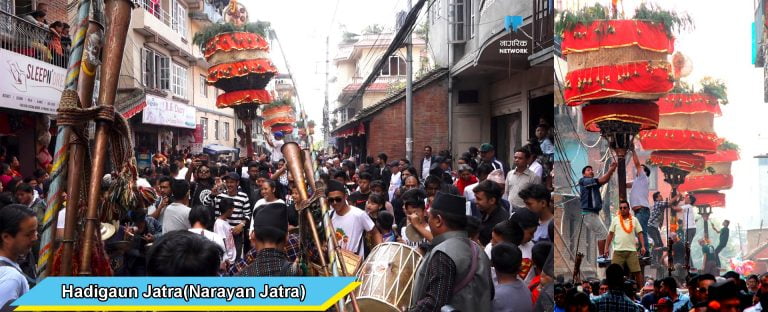
Kathmandu, the capital city of Nepal, is famous for its unique Jatras (Parades) and festivals. When it comes to Jatra, the first thing that strikes your mind is Newari culture. For sure, Newars are one of the ethnicities in Nepal who are successfully leading every Jatras since the historical period. Among all the Jatras of Newar, HadigaunJatra is one of the popular and joyful ones. So, it is popularly known as ‘Kahi Navako Jatra Hadigaun ma,’ which means ‘Parade that takes place nowhere, but only in Hadigaun.’
Hadigaun is a small village inside Kathmandu city, which is home to the Newar community. Unlike other Jatras of Newars – IndraJatra, BisketJatra etc., this Jatra is not so popular in Bhaktapur, Patan etc. The local people of the Hadigaun mainly celebrate it to pay homage to Lord Vishnu. So, it is also known as Narayan Jatra, a century-old tradition preserved and promoted by the locals of Hadigaun.
When is it celebrated?
The remarkable thing about HadigaunJatra is that it falls on the festive month in Nepal, i.e., either September or October. It is celebrated on the last night of Dashain – the grand festival of Nepalese. It is the only Jatra in Nepal that starts and ends on the same night. However, the preparation for this Jatra begins from the second day of Dashain.
What is the story behind HadigaunJatra?
There is a popular myth and story regarding the beginning of this festival. According to the mythology, once the women, having the labor pain because of pregnancy, insulted the Lord Bishnu, who was in Human ‘Avatar.’
Lord Bishnu was passing by the path, and he saw the women crying because of the pain. To help her, he consoled her and asked her to chant the ‘Bishnu Bishnu.’ However, it didn’t work as she got annoyed and didn’t do what she was asked for. She immediately asked him to leave. As a result, Lord Bishnu became furious and went directly to the Himalayas and cursed her.
Because of the curse given by Lord Bishnu, she couldn’t give birth for 12 years and was in an extreme level of pain. To help a woman, villagers of Hadigaun gathered together and decided to get to Lord Bishnu for his help. However, upon reaching him, he refused to help them.
Finally, one man convinced him to return Hadigaun upon one condition. All of the villagers promised to show him a Jatra that takes nowhere, but only in the Hadigaun. After hearing this, Lord Bishnu was pleased and promised to pay a visit to the village during the occasion.
After the excellent preparation, villagers held the grand Jatra that was truly amazing. Lord Bishnu appeared with great happiness and blessed the women. Finally, women succeed in giving birth to a baby boy. It is said that the newly born baby had a mustache because of his late delivery.
Since that day, villagers of Hadigaun have been continuously conducting this Jatra. This Jatra has become the identity of this place. The main reason behind its continuity is to please Lord Bishnu and protect the village from bad happenings.
What are the preparations for HadigaunJatra?
The preparation for this Jatra begins from the second day of Dashain. The priests gather together and make the wax flower, which is mandatory for this Jatra. Along with the flowers, other offerings are also brought from Shivapuri and offered to Lord Bishnu’s idols by the priest and from the priest’s home. Villagers start to build the three Chariots without wheels. The saucer-shaped Chariots are used in Jatra, consisting of the offerings prepared by priests and villagers. Also, Chariots consist of an idol on top and a pinnacle on the bottom.
How is it celebrated?
Unlike other Jatras, it doesn’t continue for long days. Its real show begins and ends on the last night of Dashain. After the completion of preparation, on the previous night of Dashain, all the villagers and priests scatter in three different areas of Hadigaun –KotalTole, NyalmaTole, and BhimsenTole. Each Chariot from those three areas is taken out and rounded in Hadigaun after priests complete the worship.
Each Chariot represents Lord Bishnu, Lord Brahma, and Lord Maheswora, respectively. However, it is also said that three chariots are built representing women cruised by Lord Bishnu, her son, and her husband.
Each Chariot is carried by devotees on their shoulders and is rotated within Hadigaun in the clockwise direction. The chariots are rotated in villages with the faith that they will bring security, happiness, and coordination among the villagers. After taking rounds, Chariots are left on the streets so that worshippers can perform puja and take blessings from it. Later, Chariots are pulled apart, which marks the end of the Jatra.
Besides these, villagers also show their kind of happiness and celebration during this Jatra. Locals prepare the different delicacies and serve them to each other. All the villagers share their joy, pains, and affection by wearing a unique dress and ornaments. The streets of Hadigaun become vibrant, and people drink and dance throughout the way.
Overall, HadigaunJatra is the one with special rituals, which can be seen only here. Even after this long, it is our privilege to see this Jatra being performed with the same level of energy and determination. Even though it is highly celebrated only in Hadigaun, every Nepalese must promote this festival. If we succeed in preserving it, we will automatically succeed in promoting Nepal’s rich culture. So, let’s join hands together and become a part of this Jatra every year.
-Article written by: Kusum Kharel for Land Nepal